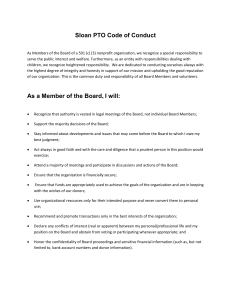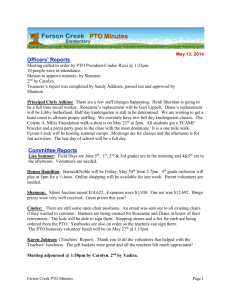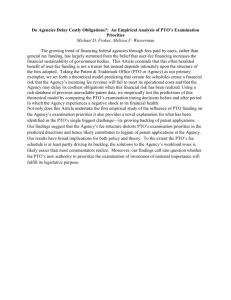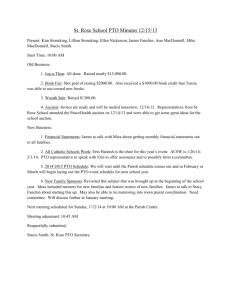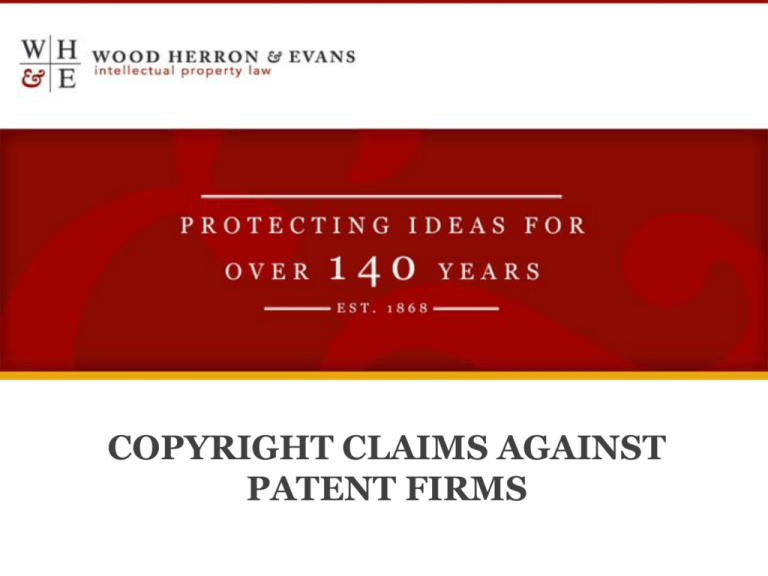
COPYRIGHT CLAIMS AGAINST
PATENT FIRMS
Steve Gillen
Wood Herron & Evans LLP
2700 Carew Tower
441 Vine Street
Cincinnati, OH 45202
513.241.2324 ext 470
sgillen@whe-law.com
Copyright © 2012 by Steve Gillen. All rights reserved. The opinions expressed herein are those
of the author, given the information available to him at this time, and not necessarily the opinions
of Wood Herron & Evans LLP or of any of its clients. The author reserves the right to change his
opinion in response to additional information as it may become known to him.
The Back Story
• STM publishing (scientific/technical/medical) is a
$15B market
• 4 publishers control more than half of it
STM Market Share
Others, 49%
Elsevier, 25%
Springer,
10%
WileyBlackwell,
7%
Wolters Kluwer,
9%
The Back Story
• STM is one of the more profitable
segments of publishing
• But as pressure on library budgets
increases, margins are shrinking
STM Publishers vs. Research Libraries
Increasing Pressure on STM Revenue Over the
Past 10 Years
The Back Story
• STM publishers have responded by:
– migrating publications from print to digital (where
they are licensed rather than sold so that publishers
have more control)
– and by bundling (in 2011, Elsevier forced Purdue U. to
take an all or nothing package for a $2.9M one-year
license fee); Harvard’s annual cost is $3.75MM and
has grown 145% in last 6 years
– Lobbying for legislation
• Research Works Act in 2012
– and, evidently, by casting about for new revenue
sources . . .
Enter: the patent prosecutors . . .
• Patent applicants have a duty to disclose to the PTO all
information known to the applicant to be material to
patentability
• 37 CFR 1.56
• They fulfill this duty by submitting Information Disclosure
Statements (IDS’s)
• 37 CFR 1.97
• Some of the relevant info is non-patent-literature (NPL) and
some of this includes copyrighted journal articles
• An IDS must include a legible copy of each publication or the
relevant portion of same
• 37 CFR 1.98
Enter: the patent prosecutors . . .
• Patent prosecution firms complying with
IDS obligations on behalf of their clients:
– make a copy for their file
– make a copy for their client
– make a copy to submit to the PTO
Enter: the PTO
• PTO also makes copies of NPL:
– when citing the art to an applicant
– when providing an official copy of the file
wrapper to the public (for a fee)
The Lawsuits
• The plaintiffs:
– John Wiley & Sons (Blackwell Publishing is a
subsidiary) - $2B/yr business with 57% from
its STM side
– American Institute of Physics - $74M/yr
business (not all of which comes from
publishing); 501(c)(3) status (tax preferenced
charity)
The Lawsuits
• Lead counsel for both plaintiffs in all 4 lawsuits is
Dunnegan & Scileppi of Manhattan
– (one 30-year lawyer and four others; they have
handled two other cases for Wiley in recent years)
The Defendants
• Feb 29
– Chicago firm of McDonnell Boehnen Hulbert &
Berghoff in ND IL
– Minneapolis firm of Schwegman Lundberg &
Woessner in D MN
• April 20
– Dallas firm of Winstead PC in ND TX (Blackwell
and AIP are plaintiffs in this case)
– Overland Park KS firm of Hovey Williams in D KS
The Complaints . . .
• 7-page, bare-bones, cookie cutter
– Δ is identified as a party that claims expertise
in IP
– One article from each π is cited as having
been infringed (with the © registration
identified by reg. # but not attached), but the
associated patent case is not identified
The Complaints . . .
• Interestingly . . .
– In ND IL, Wiley is identified as a “United Kingdom corporation
with its principal place of business in Chichester, England” (note
that UK law does not provide for “corporations”)
– In D KS, Wiley is identified as a “New York corporation with its
principal place of business in Hoboken, New Jersey”
– In D MN, Wiley is identified as a “Delaware corporation with its
principal place of business in Hoboken, New Jersey”
– In ND TX, Blackwell is “a company registered in England and
Wales with its principal place of business in Oxford, England”
The responses
• One answer (Chicago)
• Two motions to dismiss (Minneapolis and
Dallas)
• One dismissal with prejudice (Kansas)
Chicago
• Rep’d by Kirkland & Ellis
• In a 3-page “preamble” to its answer, K&E
takes the position that MBHB is:
– Just doing what it’s always done (and what
everybody else does)
– Just doing what the PTO requires
– π’s seek to introduce a “costly new
requirement into this long-standing practice”
Chicago
• Affirmative defenses –
– Some you’d expect: non-infringement; fair
use; laches; estoppel; waiver; license; first
sale; copyright misuse; unclean hands; lack of
damages
– Some surprises: non-public distribution and
display (public display and distribution not
really part of the claim asserted); NoerrPennington immunity
Chicago
• PTO moved to intervene (mid June); it has
subsequently intervened in MN and TX also
– Alleging harm to PTO if πs prevail
– Motion allowed 2 days later
– The next day the PTO filed its answer and
counterclaimed for a DJ of non-infringement
• Πs have challenged PTOs standing
• Πs have filed amended complaint, tweaked
ever so slightly to allege copying not in patent
prosecution but in research
Minneapolis
• Rep’d by Robert Clarida and Winthrop & Weinstine
– Moved to dismiss arguing failure to plead specific facts in
support of claim
•
•
•
•
No © certificate appended to complaint
No particular patent application cited
Failure to comply with Form 19 to FRCP
Failure to plead compliance with SoL
– π’s memo in op asserts
•
•
•
•
© not required at pleading stage (but they attach)
They alleged copying
Distribution to PTO is distribution to the public
SoL is affirmative defense
Minneapolis
• Schwegman reply
– © cert not adequate because it claims
ownership of journal issue only as a collective
work (WFH) not ownership of individual
articles at issue (and no transfer statement)
– This is very interesting (and nuanced because
of PRO IP Act 2008)
Minneapolis
• Motion to dismiss denied on 7/2
– Πs have pled sufficient facts
– Πs have pled ownership
– No requirement to attach reg. cert.
– Whether registration only as collective work is
sufficient to satisfy 411 requirement can’t be
decided at this stage
– SoL is an affirmative defense
Dallas
• Vinson & Elkins move to dismiss on both technical
and substantive grounds
– First, because lawyers have a protected fair use
right/legal duty to submit IDS to the PTO and to
maintain client files (this actually has some appeal as
we are “officers of the court” – quasi public officials
with a duty to the system
– Second because Blackwell sued on a Wiley-owned ©
– Third because the IDS was submitted in 2005
(outside the 3-year SoL; though when might this have
been discovered?)
Dallas
• MD Memo goes on to tackle fair use head on
– Purpose & character
• quasi judicial nature of PTO proceeding
• Use as “evidence” – citing cases where copy of accused
work introduced to support claim (book by ex-spouse as
evidencing unfit character for custody – e.g, some connection
between owner of work and party to the dispute)
• Use is transformative – meaning in this instance that it was
used not for research but as prior art (I don’t think this is what
we mean by transformative)
• Not a commercial use or exploitation – used because it is
required, not to make a profit (but cf. Kinkos; Basic Books;
American Geophysical)
Dallas – MD Memo
• Nature of the work
– Factual and evidentiary character (true
enough)
– Used for factual rather than expressive
content (if this were so, paraphrasing would
be good enough)
Dallas – MD Memo
• Amount and substantiality – they argue
this factor is neutral because they only
copied the whole article because they
were required to . . . (really?)
Dallas – MD Memo
• Effect on market or value –
– it’s old news;
– no market for it;
– we paid for it once already (as part of a
licensed database - what about breach of
contract claims?)
– CCC offers blanket or ala carte options;
online; cheap; good STM coverage
Dallas
• Πs brief in opposition concedes copies to
the PTO and focuses on research copies
(Texaco case)
• Ignores ownership issue (but they have
since filed an app to amend ownership)
• Argues that there are issues of fact on fair
use factors
Overland Park
• Rep’d themselves and dismissed with
prejudice before answer or other motion
PTO Internal Position Paper
• Addresses use by PTO
– Copies for use in examination and copies to
applicants when prior art cited against them
– Copies to public as part of file histories (for a
fee); but not on Public PAIR
• And use by applicants
PTO Internal Position Paper – Fair Use Analysis
• Purpose and character
– Non-commercial, governmental (yes)
– Transformative (doubtful)
PTO Internal Position Paper – Fair Use Analysis
• Nature of the work
– Published
– Fact intensive
PTO Internal Position Paper – Fair Use Analysis
• Amount and substantiality
– PTO claims this is neutral
– Makes an effort to take only portion relevant
and instructs applicants to do the same (but,
with a wink and a nod, acknowledging that
taking less than the whole is often not an
option)
PTO Internal Position Paper – Fair Use Analysis
• Market effect
– No market for NPL because it is old, they
don’t put it on PAIR, and they have not
historically paid for it so there is no active
market (what about CCC?)
PTO Internal Position Paper – Fair Use Analysis
• Same analysis for use by applicant
– Acknowledging that law firms are for-profit, but
arguing that they are not “exploiting” the work but
just submitting it
– Noting also that since the works have often been
initially obtained through licensed access, they
have already paid for it once (sound familiar?)
– This for submission to the PTO only; they take no
position on file copies or client copies


